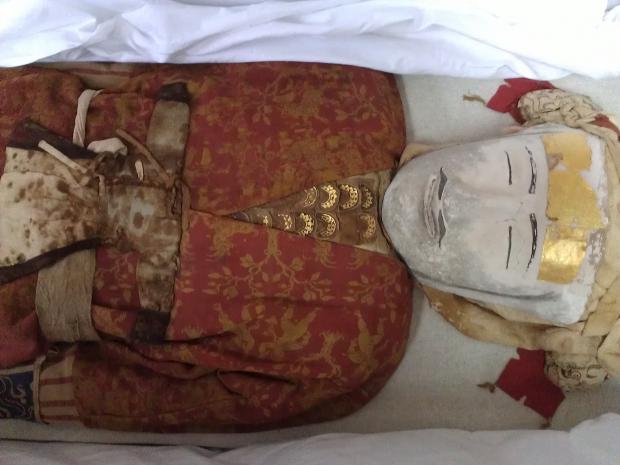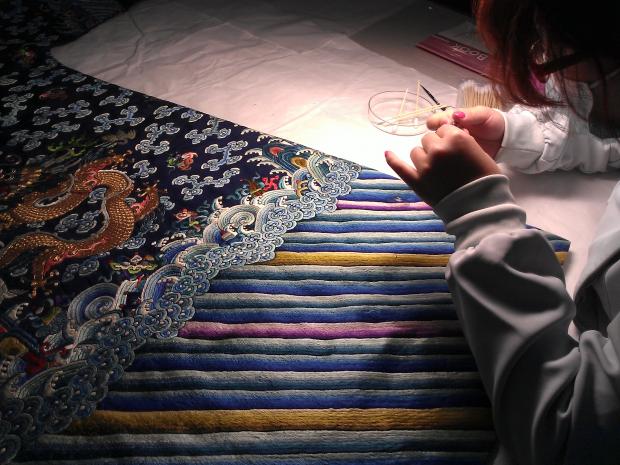By: Anne Ringgaard, Journalist
A Danish research is world renowned for making isotopic analyzes of textiles. The method reveals how people traveled and traded for thousands of years ago. Now she helps the world's best silk researchers to gain new knowledge of China's history.

One of China's most famous mummies Yingpan-man from the 4th-5th century e.Kr found on the China National Silk Museum in Hangzhou. (Photo: Karin Margarita Frei)
Technologically, economically and intellectually, we lag after the Chinese, we often hear in the media, which also brings one feature after another on China's nationalism, lack of human rights, horrible food, overcrowding and very strange culture.
Here comes another story: Many years and smoothly researcher collaboration suggest that Danes and Chinese maybe not always as far apart as we might be led to believe.
Videnskab.dk have met the Chinese professor Dr. Zhao Feng, when he met his Danish collaborators at the Danish National Research Foundation's Centre for Textile Research in Copenhagen.
"We live in a globalized age where we need to work together across borders, but in China, scientists have not had a tradition of having little to do with the West, partly because my generation grew up during Mao's cultural evolution, where we did not learn English, "says Dr. Zhao Feng, head of the world's largest silk museum China National Silk Museum in Hangzhou.
China needs international cooperationProfessor Dr. Zhao Feng is an exception: For years, he worked with foreign researchers among others from Denmark, and in his time he studied at the Metropolitan Museum in New York. Currently he gets help from the Danish textile research center to gain new knowledge about the historical trade route known as the Silk Road.
Younger Chinese forskerspirerer have also begun to open up to the outside world, he says.
"The new generation are increasingly traveling out to study in the United States and Europe. That's good, because even though China is large in size, we are not as developed. We still have much to learn. "
The internationalization of Danish research increasesOver the last decade there has been a significant development in the internationalization of Danish research. Figures from the Research Barometer 2010 and the Nordic Research shows, for example, increase in the share of scientific publications in international cooperation:
1984-1988: 23 percent
1994-1998: 42 percent
2004-2008: 55 percent
The method of calculation is that at least one researcher is based in Denmark and at least one researcher living abroad.
In the same period, the focus on elite research increased and the Danish National Research Foundation Center of Excellence by the Centre for Textile Research is among, have helped to increase internationalization.
Danish help to analyze silkAlthough Dr. Zhao Feng's museum specializes in ancient silk and is a global leader when it comes to analysis of several thousand year old silkestoffers colors and structures can Centre for Textile Research something that the professor would love to learn:
Centre researcher, postdoc Karin Margarita Frei, is known throughout the world for having developed a method for finding prehistoric textiles origin. She does so by making analyzes of the strontium isotope textile values.
Strontium isotopes talks about past societiesStrontium (Sr) is a chemical element, which so closely resembles calcium that living organisms treat the two drugs almost identical. The Human Body recorder such as strontium in the bones as a substitute for calcium.
The substance found in plants, soil and water and is led to animals and humans through food and drink. Scientists have long made analysis of strontium isotopes in Mummies bones and teeth. By comparing mummies strontium isotope values ??with the composition of strontium isotopes in different geographic locations, scientists can track how the mummified people once lived and raised.
"The knowledge strontium isotope analysis gives us about how your ancestors migrated and left, telling us about the prehistoric samfundsdynamikker and we can see if there has been a social and societal relations between different geographical areas. The background is the basis for the society we have today, and it has made us what we are, so it is important that we are doing it, "said Karin Margarita Frei, who specializes in archeometry.
The world's first strontium isotope analysis of textilesWool, linen and other textiles made from organic material also contains strontium. As the first in the world use Karin Margarita Frei the analytical methods hitherto used skeletons to determine how prehistoric clothes, for example, is found in oak coffins from the Danish Bronze Age graves are made. On the way, she finds and colleagues out if past people have traveled and traded with people from other countries.
"For the first time, you can make strontium isotope analysis of textiles. It's got a lot of attention worldwide, because it is the first time we have a method that can say something about how archaeological textiles raw materials come from, "says Karin Margarita Frei.
By making strontium isotope analyzes of wool from ancient times, she and colleagues among others found out that Denmark already 2,000 years ago was with wool also outside the country.
Silk is a very special material
Researchers from the China National Silk Museum in Hangzhou preserves silk. (Photo: Karin Margarita Frei)
"The Chinese are very interested in developing a method so that they can make strontium isotope analyzes of their ancient silk fabrics but silk is a completely different type of fiber than wool and linen, so we can not simply use the method we have used for the Danish archaeological textiles, "explains Karin Margarita Frei.
'Prehistoric silk is very fragile and valuable, so we have to start from scratch and develop a new method that we can test modern silk. Only then can we develop the method of prehistoric silk, "she continues.
Strontium is a trace element which is to say that it is present only in very small amounts in the fabrics. Karin Margarita Frei and his colleagues need to be sure that there is enough of it in small quantities of silk, they are allowed to explore when working with irreplaceable archaeological material.
"We have to discard all other elements from, so there is only strontium back. It is a very difficult process that requires time and expertise, "says Karin Margarita Frei.
The Chinese are silk expertsKarin Margarita Frei has repeatedly got prestigious awards and grants for his work. For example, she received the 2012 UNESCO For Women in Science just to explore the possibilities for analyzing strontium isotopes in modern silk, and in 2009, she was named elite research .
For four years she has shared knowledge and worked with Zhao Fheng and his colleagues from the Silk Museum in Hangzhou. Despite the geographical distance, cooperation so well that the two research groups have plans in the future to use each other's laboratory facilities.
"We use each other's expertise to get a dimension on. Researchers at the Silk Museum in Hangzhou has exceptional knowledge of color analysis and silk fibers. On the other hand, we have the only laboratory in the world that make strontium isotope analyzes of textiles, "says Karin Margarita Frei.
Laboratory of strontium isotope analysis with facilities to analyze textiles found at the Danish Centre for Isotope Geology, Department of Earth Sciences and Natural Resource Management at the University of Copenhagen.
"At the start of the Chinese researchers plan to do a lab like ours, but now they have realized that we should not have two similar laboratories. It is better that they use our expertise and laboratory. You can not do everything, so we share our research, "says Karin Margarita Frei.
Strontium isotope values ??across China to be mappedMaking strontium isotope analyzes of ancient Chinese silk is a comprehensive project because it requires geologists and geochemists maps the strontium isotope values ??everywhere in China. Karin Margarita Frei know the process, along with Robert Frei, a professor of geochemistry, she has created a map that shows the distribution of strontium isotopes in the Danish countryside.
But Denmark covers an area of ??only approx. 42,000 km2, while China has over 9 million km2.
"It took 2-3 years to make the map of strontium isotope ratios in plants and lakes everywhere in Denmark, so it comes naturally to take much longer in China. It is a complicated process and there are numerous factors you should consider. For example, the latest research that may have come strontium with dust, for example, from volcanic eruptions, which may have altered the fact that originally, "says Karin Margarita Frei.
Still, it pays to make a map of how strontium isotope ratios are in different geographic locations in China, land is the world's third largest country.
"With such a map, we can learn a lot about historic trade routes, including on the famous Silk Road. It can also be used for various purposes - for instance by today's garment to trace the origin of textiles, "says Karin Margarita Frei.
Danes and Chinese moves quicklyAs Videnskab.dk met Karin Margarita Frei and Zhao Feng in Danish Centre for Textile Research facilities in Amager, they agreed on most things. Both said that their research groups have similar work mentality in the sense that they move quickly when they've got an idea for a new joint project. The collaboration is rewarding and smoothly, they say.
"Denmark is the only country in the world where there is a research center specializing in archaeological textiles, such as the Centre for Textile Research in 2009 came to visit in Hangzhou, we quickly agreed to enter into a partnership. Since then we have constantly exchanged ideas and we have made a number of projects together. It is always the case that one of our projects generates a new, "said Zhao Feng.
"Our cooperation is driven by curiosity, and it is essential that it has emerged from below and not from above. Our government has the ambition that Chinese scientists will work with researchers from other countries, but if it's something like that is pressed down on us from above, it works hardly as good as our cooperation've done, "he continues .
Important to be globally orientedThe globally-oriented Chinese professor has started an exchange program, so that students at his museum will have the opportunity to be inspired by researchers in other parts of the world, just as he has been.
"I think a lot about the next generation of scientists, I would like to have in my museum. If you really need to be challenged on its values ??and knowledge, it is necessary to go abroad, "said Zhao Feng.
Global orientation, good will and curiosity is not the only thing that keeps the Sino-Danish cooperation going. The two teams are fortunate that they both have had sufficient funds to be flexible and constantly putting new projects, emphasizing the two researchers.
Originated from:
http://videnskab.dk/kultur-samfund/enestaende-dansk-teknik-kan-give-kinesere-ny-viden-om-deres-forhistorie


 Pay attention to us
×
Pay attention to us
×